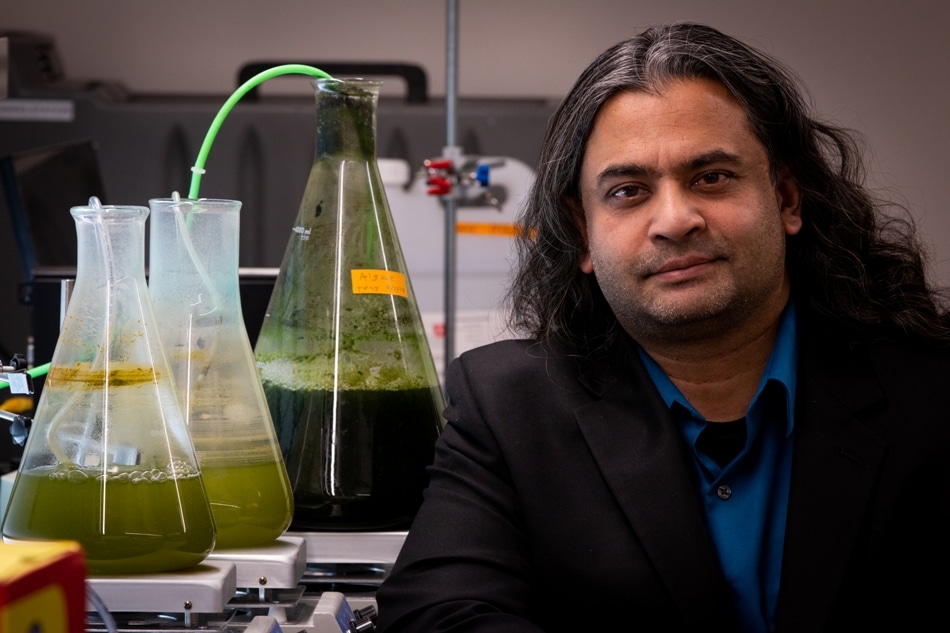Mar 5 2019
Biofuel experts have spent quite some time in trying to discover a more economically feasible way to convert algae into biocrude oil in order to power ships, vehicles, and also jets. Researchers from the University of Utah now believe that they have finally arrived at an answer. These researchers have developed a strange yet rapid technique capable of delivering inexpensive algal biocrude in huge quantities with the help of a specially designed jet mixer.
 University of Utah chemical engineering assistant professor Swomitra Mohanty, pictured with beakers of algae, is part of a team that has developed a new kind of jet mixer for turning algae into biomass that extracts the lipids with much less energy than the older extraction method. It is a key discovery that now puts this form of energy closer to becoming a viable, cost-effective alternative fuel. (Image credit: Dan Hixson/University of Utah College of Engineering)
University of Utah chemical engineering assistant professor Swomitra Mohanty, pictured with beakers of algae, is part of a team that has developed a new kind of jet mixer for turning algae into biomass that extracts the lipids with much less energy than the older extraction method. It is a key discovery that now puts this form of energy closer to becoming a viable, cost-effective alternative fuel. (Image credit: Dan Hixson/University of Utah College of Engineering)
Lipids, known to be fatty acid molecules with oil that can be separated to power diesel engines, are packed inside the microorganisms growing in rivers, lakes, and ponds. Lipids are called biocrude when they get extracted. This indeed makes organisms like microalgae a striking form of biomass, organic matter used as a sustainable fuel source. Lipids are also present in a wide range of other single-cell organisms like yeasts used for processing cheese. However, the issue with using algae for biomass has forever been linked to the amount of energy it consumes to pull the biocrude or lipids from the watery plants. Existing methods consume extra energy to convert algae into biocrude when compared to the amount of energy that is obtained out of it.
Chemical engineers from the University of Utah have developed a new type of jet mixer that has the potential to extract the lipids using relatively less energy than that consumed by the older extraction method. This indeed is a vital discovery that presently puts this type of energy closer to becoming a feasible, inexpensive alternative fuel. The new mixer is also fast as it extracts lipids within seconds.
The team’s results have been featured in a new peer-reviewed journal, Chemical Engineering Science X. The article titled “Algal Lipid Extraction Using Confined Impinging Jet Mixers” can also be downloaded.
The key piece here is trying to get energy parity. We’re not there yet, but this is a really important step toward accomplishing it. We have removed a significant development barrier to make algal biofuel production more efficient and smarter. Our method puts us much closer to creating biofuels energy parity than we were before.
Leonard Pease, Study Co-Author, University of Utah
Scientists presently extract the oil-rich lipids from the algae by first pulling the water from the algae and then leaving either a dry powder or slurry of the biomass. This is considered the most energy consuming part of the whole process. This is followed by mixing the residue with a solvent in which the lipids get separated from the biomass. What is left behind is a precursor, the biocrude, used for generating algae-based biofuel. That fuel then gets mixed with diesel fuel to power tractors, long-haul trucks, and other huge diesel-powered machinery. However, because it needs too much energy to extract the water from the plants at the very start of the process, converting algae into biofuel has until now not been a practical, economical, or efficient process.
There have been many laudable research efforts to advance algal biofuel, but nothing has yet produced a price point capable of attracting commercial development. Our designs may change that equation and put algal biofuel back in play.
Swomitra “Bobby” Mohanty, Study Co-Author, Assistant Professor of Chemical Engineering, University of Utah
Other co-authors include former University of Utah chemical engineering doctoral student Yen-Hsun “Robert” Tseng and University of Utah chemical engineering associate professor John McLennan.
The team has developed a new mixing extractor, a reactor capable of shooting jets of the solvent at jets of algae, producing a localized turbulence in which the lipids have been observed to “jump” a short distance into the stream of solvent. This is followed by taking out the solvent and recycling it so that it can be used again in the process.
Our designs ensure you don’t have to expend all that energy in drying the algae and are much more rapid than competing technologies.
Swomitra “Bobby” Mohanty, Study Co-Author, Assistant Professor of Chemical Engineering, University of Utah
Mohanty states that this technology can be used not just for algae but also for microorganisms such as fungi, bacteria, or any microbial-derived oil.
According to the U.S. Department of Energy, almost 5% of overall primary energy consumed in the United States came from biomass in 2017. Other forms of biomass include ethanol that is produced from crops such as sugar cane and corn, burning wood for electricity, and yard waste and food in garbage that is turned into biogas.
The advantage of algae is that it can be grown in raceways, ponds, or custom-designed bioreactors and then harvested to generate huge quantities of fuel. Growing algae in such large quantities can also positively impact the atmosphere by decreasing the amount of carbon dioxide present in the air.
This is game-changing. The breakthrough technologies we are creating could drive a revolution in algae and other cell-derived biofuels development. The dream may soon be within reach.
Leonard Pease, Study Co-Author, University of Utah